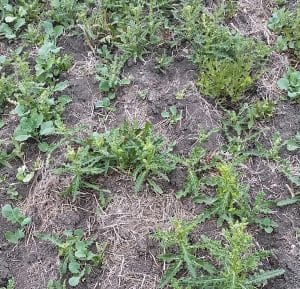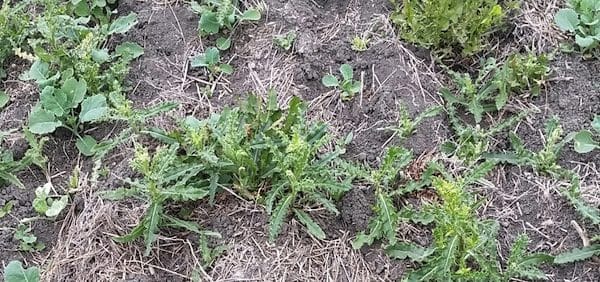Weeds are coming up strong. As part of the Canola Council of Canada’s Keep It Clean campaign, we remind growers to use only registered pesticides when required. Refer to product labels for proper use instructions.

Here are strategies to improve weed control results for each HT system:
Clearfield (IMI tolerant)
Group 2 products for the Clearfield system in general perform well with coarse sprays. Do not spray Group 2s if temperatures of 5°C or lower are forecast within 3 days of application. Treat crops during warm weather when weeds are actively growing and soil moisture is adequate for rapid growth. Under cool or dry conditions, control of some weeds may be severely reduced.
Crop staging: The application window is 2- to 7-leaf stage of the crop for Ares, and 2- to 6-leaf stage for other IMI products. Growers have various product choices, with several different tank mix partners. Ares, Odyssey Ultra or Tensile can be applied only once per season (no split applications) and cannot be followed by a related product. If the crop needs treated again for some reason, it needs to be treated as a non-HT crop for the second application. However, Ares and Odyssey Ultra — products containing imazapyr — all have some flushing weed control from residual soil activity.
If thistles are a target: Ares may be mixed with Lontrel 360 at 84 mL/acre. Odyssey may be mixed with Lontrel at 0.17 to 0.23 L/acre. Tensile is a co-pack of Solo and the dry Lontrel formulation.
Liberty Link
As a contact herbicide, Liberty is recommended to be applied as medium to slightly coarse droplets (approximately 200 – 350 microns) and typically needs water volumes of at least 10 gallons per acre to maintain efficacy at that spray quality. Liberty generally works best in bright sunshine when temperatures are warm and weeds are actively growing.
Growers will benefit from spending additional time evaluating factors such as environmental conditions at application, water volume, application speed, sprayer nozzle choice and application pressure to find a combination of these along with their choice of Liberty rate or tank mix partner that can balance issues such as drift control, yet maximize product effectiveness. Most control issues for herbicides that rely heavily on contact activity, such as Liberty, are related to poor coverage from insufficient water carrier volumes, combined with a coarse or very course spray pattern and/or late stage at application.
Crop staging: The application window for Liberty is from emergence to early bolting. Set the rate based on weed species and pressure. Split application is an option, but the maximum allowable rate per season is 2.97 litres per acre. Liberty may be tank mixed with clethodim at up to 50 mL/acre for additional control of grassy weeds.
The mixing order is unique when tank mixing clethodim with Liberty. Add the surfactant first, then Liberty, then clethodim. This is one of the only times when surfactant goes in the tank first. Click here for more on pesticide mixing rules.
Grassy weeds. If a field of Liberty Link canola has lots of green foxtail and not much else, Liberty has a label rate of 0.54 L/ac for that situation. But we stress that this low rate requires good scouting across the whole to ensure that other weeds are not present. This low rate is inadequate for most weeds. Refer to the crop protection guides for the various rates.If wild oats and other grassy weeds emerge before broadleaf weeds, consider a Group 1 alone, then follow up later with Liberty. If you want to stick with one pass, the mix of Liberty plus clethodim works well on heavy grass populations. Note however that if wild oats are Group 1 resistant, then the Group 1 tank mix will not be any better than Liberty alone.
Thistles. Lontrel cannot be tank mixed with Liberty. If using Lontrel for thistle control in Liberty Link canola, it should have its own separate application according to label rates and staging, either before the Liberty application or after the thistles recover following the Liberty application. For acceptable control, Canada thistle should have ample leaf area in a living condition for contact and uptake. For this reason, if thistles are the major problem weed, Lontrel should perhaps go before the Liberty.
Roundup Ready
Glyphosate is suited to low drift (coarse droplet) sprays, but at low water volumes coarse sprays may not provide enough droplets per square inch. A combination of coarse spray and low (but not ultra low) water volume is best to make sure you get droplets on even the smallest weeds. Use at least 5 Imperial gallons per acre. Larger droplets from higher water volumes also reduce the drift risk.
Key steps to get the most out of glyphosate:
—Weeds should be actively growing. Plant growth stops below 5°C. Delay applications for at least 24 hours, preferably 48 hours, after temperatures near 0°C to allow plants to recover and begin growing again.
—Use water volumes of 5-10 gallons/acre when water quality is good. Water volumes at the lower end of the range are recommended with hard water. Add ammonium sulphate to the water at 1% of total spray volume to reduce hard water antagonism. Find another water source for spraying glyphosate if hardness exceeds 40 grains/US gallon total hardness (700 ppm CaCO3 equivalent). See the Saskatchewan Agriculture factsheet on spray water quality.
—Smaller weeds are easier to control. Growers want to make every effort to control species such as buckwheat and winter annual weeds at the 1-3 leaf stage.
—Sunny, warm and humid are optimum conditions for top performance. This includes warm temperatures through the night.
—Avoid travel speeds during spraying that will create large amounts of dust. Clark Brenzil, provincial specialist in weed management with Saskatchewan Ministry of Agriculture, says that if dusty conditions cannot be avoided, spray from downwind to upwind to minimize the dust deposition on unsprayed leaves. Front mounted booms will also help this to some degree.
Crop staging: The window for glyphosate on Roundup Ready canola is from seeding to the 6-leaf stage of the canola crop. Application earlier than the 1-leaf stage is OK — unless the crop and the weeds are under stress. In that case, hold off until conditions improve for better weed control and to avoid stalling the crop. Applying after the 6-leaf stage or above label rates is known to cause yield loss. Maximum use rates are 270 g ae per acre on one application or two applications of 180 g ae/acre each. When going after thistles, buckwheat, and large dandelions, a tank mix of glyphosate and Lontrel 360 (co-packaged as Eclipse) at the 112 ml/acre rate can be applied after the 2-leaf stage.
For the final word on herbicide rates and timing, check the product label and consult the guide to crop protection for your province: Alberta Saskatchewan Manitoba
Further reading:
12 tips for better spray results
Drift management tips
Tips for spraying in the wind
Safe handling of crop protection products

